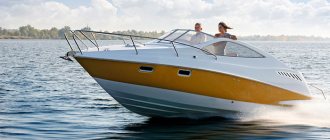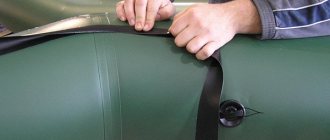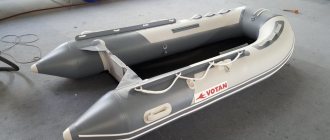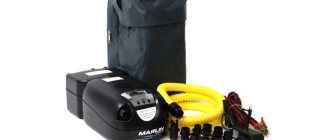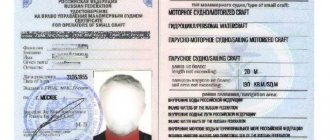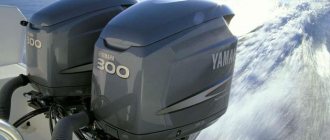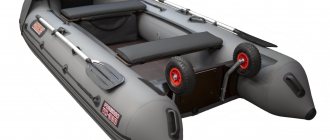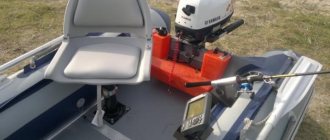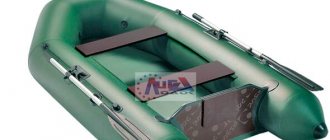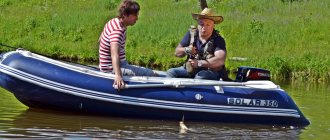Gasoline engines run on fuel. This allows the owner to take a certain supply with him to refuel the fuel tank if the fuel runs out. In the case of an electric motor with “refueling”, difficulties may arise.
Before purchasing, consult with the seller and choose the optimal charge source for your electric motor. What types of traction batteries are there, and how to choose the best battery for an electric boat motor? Let's talk about this.
Features of batteries for boat motors
Electric motors have both positive and negative aspects of operation. For example, if you are far from civilization, you do not have access to the power grid. This means you cannot charge the battery for the electric motor. But, on the other hand, the cost and maintenance of such engines will be cheaper than gasoline ones. Beginning boaters, when purchasing an electric motor, also sometimes forget to buy a traction battery for it.
The autonomy of traction batteries is an undeniable advantage. When purchasing a traction battery, you need to remember the following rules:
- Under no circumstances should you open the case. They are specially made non-separable to prevent oxygen from accessing the plates, as this can lead to oxidation and failure of the unit.
- If you purchased a high-capacity battery, you need to install a charge limiter on it, otherwise the engine will burn out when a high charge is applied.
- When purchasing a lead-acid battery, be aware of its toxicity. If the housing is suddenly pierced, it must be disposed of in a toxic waste collection area. Lead is a heavy metal that can cause irreparable harm to health.
- You should not allow the charge level of an acid battery to drop below 20%, this will negatively affect the battery life, especially for batteries with liquid electrolyte, after 4-5 deep discharges, they become unusable.
Onboard boat charger
Boaters who purchase a traction battery need to know that such batteries should not be stored in an unheated room in winter, since at temperatures below -20 Celsius they may become unusable.
And also, you should not expose them to heat or prolonged exposure to direct sunlight - when the mark passes +60 Celsius, the likelihood of an explosion increases in proportion to the temperature increase.
Selecting a battery for an electric motor
Let us dwell on such a serious issue as choosing a battery for an electric motor. It must be stated that choosing a battery for an electric motor is not as easy as it might seem at first glance.
What are the pitfalls here? The fact is that an electric motor means a deep discharge of the battery, and if we fish on a boat with an electric motor for a whole day, it is entirely possible that by the end of the day the battery will be completely discharged. It should be emphasized that when using simple car starter batteries, a starter battery that is discharged to zero very soon becomes unusable because sulfation occurs. The fact is that starter batteries are designed to be used in buffer mode, in other words, they must be in constant recharging mode.
And if we do not recharge them constantly, but charge them after the battery has completely discharged, i.e. We do deep cycles: charge-discharge, charge-discharge, then sulfation occurs, and the starter battery very soon loses capacity. How can we prevent this from happening? For example, to sail on an electric motor all day, you need a battery with a capacity of at least 85A/h. Many fishermen do the following: they put a battery in the boat - a simple starter battery with a capacity of 150-200 A/h. This, of course, is a fairly large and heavy battery. But at least it allows you to fish all day, and if you swim on it not at the fifth speed, but, for example, at the third, no more than half the battery capacity is discharged per day.
Thus, the battery does not reach a deep discharge; it can be recharged and used. But if we need a harmonious “boat, battery and electric motor” system, we need to opt for deep-discharge batteries. What is the advantage of deep discharge batteries? The fact is that if such a battery is completely discharged, it can remain discharged for about 2-3 weeks, after which it can be charged again, and it will fully retain its properties. Starter batteries do not allow this, in other words, when the starter battery is discharged, it must be recharged immediately.
But after complete discharge, the onset of sulfation is inevitable, even if we immediately begin to recharge it, and the battery is already losing capacity. In addition, deep-discharge batteries do not have the function of self-discharge. While starter batteries, as we have already said, are designed to be in a constant recharging mode, based on this they have a fairly rapid self-discharge. So, if we charged a car battery with them, installed it and forgot about it for 6 months, then perhaps after six months we will have to throw it away. Based on this, simple batteries for cars with starter batteries need to be recharged every one and a half to 14 days, and then they will be stored normally. But we recommend that you immediately abandon their use and opt for a deep-discharge battery - these are the so-called gel batteries, maintenance-free. They allow deep discharge and, what is also extremely important, are completely sealed.
Now, for example, the wave is not huge, but with a huge wave the boat rocks very strongly, and an electrolyte leak can occur from a simple starter battery, which can burn the fisherman’s clothes and can break an expensive boat. Based on this, it is better to refuse this and not mess with car batteries. It goes without saying that a car battery costs significantly less than a deep discharge battery, but as they say, “the miser pays twice.” After you throw away 2-3 simple car batteries, you will realize that it would be better to immediately purchase a gel battery that can be used for many years. What are good gel batteries and why do they allow deep discharge?
The fact is that the electrolyte in them is in the form of a gel - a thicker substance than, for example, acid in starter batteries, and preventing leakage of the gel is much easier than preventing acid leakage from starter batteries. Another difference between gel batteries and starter batteries is that they can be made completely sealed. As we know, at the moment when the charging-discharging cycle occurs, any battery emits gas. Helium batteries emit little gas, and this gas is converted by the helium electrolyte itself. Starter batteries cannot be made sealed, due to the fact that during their operation very strong gas formation occurs, which, if sealed, can lead to an explosion. A huge advantage of maintenance-free gel batteries is that they allow many complete charge-discharge cycles.
Rice. 1 For example, the Zaining Shine gel battery that we have on our boat (85A/h) (Fig. 1) allows approximately 500 deep charge-discharge cycles, this is a fairly significant figure. Charge-discharge cycles are a very important indicator of rechargeable batteries, and the more deep charge-discharge cycles your battery can tolerate, the better. Based on this, when choosing a battery, be sure to look at all its full characteristics: how many deep charge-discharge cycles it allows, at what current it needs to be charged, etc.
The undoubted advantage of gel batteries is that they have very little self-discharge, in other words, when charged, they do not actually lose capacity. And based on this, having charged the battery, we can leave it unattended for a couple of months, then put it in a boat and sail all day. Self-discharge, of course, exists, but it is very insignificant. Helium batteries have only one significant drawback - the high price. It must be stated that the price of a good, high-quality gel battery is comparable to the price of an electric motor, and in some cases it is even higher than the price of an electric motor. But if the funds allow you, then it is better to immediately opt for a gel battery. As for capacity, according to our point of view, the battery capacity for an electric motor should be at least 85A/h.
It goes without saying that the more the better, the optimal capacity is up to 100-105 A/h, with it we can sail all day on battery power without any trouble. Moreover, if we swim at first, second, third speed, then a battery of such capacity can also be stretched for two days of fishing, and we will have enough energy to sail for two days on a motor and not take up the oars. If we have already decided on the type of battery for the electric motor, then it’s worth talking about the charger separately and in more detail.
The fact is that there is a special charger for each battery. The main rule according to which the charger must be matched to the battery (or the battery to the charger) is that the battery must be charged at a current equal to 1/10 of the battery capacity. For example, if a domestic battery has a capacity of 85 A/h, then the perfect charger for it would be one that would make it possible to set a current of 8.5 A. It is at this current that the battery should be charged, no more. Otherwise, it is possible to charge the battery at a lower current.
For example, if we take a charger that allows you to charge, for example, a battery at a current of not 8.5 A, but at 5 A, as a result, we can easily quickly increase the battery charging time (at a current of 8.5 A we can charge this battery takes 10 hours, this is the minimum period required to fully charge a gel battery). If we fish, for example, once a week, then it is optimal to charge the battery not at a current of 8.5 A, but at 4-5 A; accordingly, it will take several times longer to fully charge the battery. Let's focus on a charger designed specifically for charging gel batteries.
Rice. 2
Rice. 3 The device shown in Fig. 2, charges the battery with pulsed current. It has a power meter and a current regulator that shows what current is currently set. After returning from fishing, we connect this charger to the battery. Let us remind you that you need to know how to connect the charger correctly so as not to burn the device itself and the fuse: first of all, we connect the terminals, strictly following the polarity, because changing the polarity will lead to the fuse burning. So, we connect “plus”, “minus”, and only then we turn on the device into the network and begin to set the current. We turn the handle. If we need to charge the battery soon, we set the current to 8.5 A (Fig. 3). If we plan to charge at a low current, we set it to 3-5 A. So, the battery will take longer to charge, but the charging will be of better quality, because the battery loves charging at a low current.
Rice. 4
Rice. 5 This device is very effective, so we recommend taking it. Stores sell special chargers that allow you to charge batteries of a certain capacity. For example, I have an unregulated charger that allows me to charge a battery with a capacity of 2.5 to 15 A/h (Fig. 4). But more wonderful, larger batteries do not need to be charged with such a device, it is not calculated on them. The battery, of course, will charge, but for a very long time, due to the fact that the charging current in this device is small - 1.3A. Based on this, it is better for them to charge a small, maintenance-free battery (Fig. 5). Let us emphasize that it is very effective to use such batteries in a set with echo sounders.
In order for the battery to last for 7 days of fishing with a wonderful echolocator that works at full power, the battery may not be completely discharged. By the way, a sealed battery has one more advantage: it can be picked up, turned over, shaken, it can fall on its side in a boat, and no trouble will arise. The devices shown in Fig. 4 are, in principle, good, but have a significant flaw. The fact is that the charger, which is designed for charging with pulsed current, contains a special microcircuit that heats up while charging the battery. And to prevent the device from overheating, when choosing a charger, we strongly recommend that before purchasing you make sure that it is equipped with a fan that cools the chip during charging. Without a fan, the charger will become very hot.
Rice. 6 In the depths of the niche (Fig. 6), which is intended for wires, there is a fan. Before purchasing, be sure to make sure that this fan works. If it works, you can safely take the device, and you will not have any problems with charging gel batteries. The charger for maintenance-free batteries must be automatic. In other words, after the battery has been charged, the device should smoothly reduce the current and at that moment, when the battery is fully charged, reset the charge and turn off.
So, the charger remains plugged in, works, the fan spins, but the battery is no longer charged. Because after it has been fully charged, strong gas formation may begin in the battery, you need to immediately disconnect it from the charger network. But, in most cases, it is very difficult to catch this moment, so we recommend choosing a charger with automatic shutdown. As we have already said, it is possible to easily calculate how long it will take a domestic battery to charge. We take the battery capacity of 85A and divide it by the current that we set on the charger. So, if we set the current on the charger to 8.5 A, the battery will be charged in 10 hours.
If we set a lower current, say 5A, then 85A must be divided by 5, and we will take the number of hours needed to fully charge the battery. When choosing a charger, we recommend choosing a device that can charge both the smallest batteries and the largest ones. The domestic charger, for example, has adjustment. And if we set the current to 15A, we can charge a battery with a capacity of 150 A in 10 hours, based on the formula according to which the battery must be charged at a current equal to 1/10 of the battery capacity. In addition, by setting a small current on the same device, we will also be able to charge small rechargeable batteries intended for use in echo sounders. Based on this, because we make a purchase once, we must approach it wisely.
Now let’s dwell on such an important point as the capacity of the electric motor and the suitability of the battery. For example, if we plan to sail on an Indura-30 electric motor, which at speed 5 consumes 30 A per hour, we calculate 30 x 3, which results in 90 A/h. 85 fully fits this indicator. It is believed that if we can swim at speed five for three hours, then at speed two or three we can swim for a whole day. Based on this, you can proceed to choosing a battery and an electric motor. If we take a more remarkable electric motor, for example, “Indura-36”, consuming 36 A/h, multiply by 3 and take 108 A/h. If you take the “fifty”, in other words, the electric motor, which at the fifth speed consumes 50A per hour, you get 50 x 3 - 150 A/h, and, obviously, you need to install a wonderful huge battery for it.
The method for balancing is quite simple, and it is imperative to calculate what kind of battery is needed for this electric motor. Some electric motors are equipped with an indicator of the battery charge level, which is very convenient. But if we don’t have an indicator on the motor, then by the very behavior of the electric motor we can easily guess what state the battery is in now. For example, it was seen that at a time when the battery has about 20% capacity left, in other words, it is already actually discharged, the speed quickly drops. So, if we swim at the fifth speed, then with this state of the battery our high speed will not exceed the third. If we are sailing at third speed, then with a discharged battery the speed will drop to first. In addition, by closely observing the behavior of the electric motor, it is possible to roughly guess how long we will be able to sail on it. As a safety net, we recommend having with you a small sonar battery with a capacity of more than 7 A/h (for example, 18 A/h).
This battery is quite light, and it can serve as a source of backup power for us: in addition to the fact that it will power the echolocator, if the main battery on it is completely discharged, we can soon return to base. It is extremely important to know that in order for batteries to serve us longer, they must be fully charged and fully discharged. So, we have completely discharged the main battery, and we can already sail back on such a small battery. If the Indura-30 consumes 30 A per hour, then with such a battery with a capacity of 18 A/h, we can swim for about half an hour at speed five.
And if we take into account that the electric motor can accelerate the boat up to six kilometers per hour, then in half an hour we can sail 3 km on such a small battery, and at the same time discharge it. This benefits both us and the batteries: they are used correctly, and we are comfortable, because there is no risk that if the main battery suddenly runs out, we will need to row back to base. In addition, it is extremely useful to know how long the boat can move continuously on an electric motor and a specific battery at first, second, third, fourth and fifth speed. These numbers can be found on the manufacturer's website. And, knowing how much current a domestic motor consumes at first, second, third, fourth and fifth speed, and by dividing the battery capacity by these numbers, we can find out the time in hours, how long we can swim at first speed, at second, on the third, on the fourth and on the fifth.
Rice. 7 In addition, by taking a GPS navigator, we can find out the speed that a domestic boat develops at first, second, third, fourth and fifth speeds. Thus, we can find out not only the time, but also the path that a domestic boat can take, which is extremely important for developing routes. For clarity, we present a table that shows the dependence for “Indura-30” and a battery with a capacity of 85A/h (Fig. 7). Let us remind you that when choosing a battery, you should also take into account the fact where and by what company this battery was manufactured. For example, a domestic battery is made in Germany. And what is it famous for? This battery is guaranteed to withstand at least 500 deep discharge-charge cycles. Very reliable, time-tested, and many who use maintenance-free batteries recognize that this is one of the best companies in the world.
Rice. 8
Rice. 9 In Fig. 8 and 9 are two maintenance-free batteries made in China. In principle, the batteries are also good, but they do not reach the “Zonenshain” quality. These batteries are very similar, one of them says “Panasonic”, but they were both produced at the same factory, and their quality level is actually the same.
Rice. 10 When choosing a battery for an electric motor, take into account the fact that the battery must have a plate with the battery characteristics (Fig. 10). You need to pay attention to this because they can sell you a simple starter battery intended for a car under the guise of a maintenance-free battery.
Boat electric motor + battery
Types of traction batteries
Battery outboard motors are used in many types of transport, for example, trolleybuses, electric vehicles, forklifts. Advantages: high power reserve compared to gasoline engines, environmental friendliness and safety. For novice fishermen, the main advantage will be ease of setup and quick start-up.
Types of traction batteries:
- Gel. GEL is a deep discharge battery for outboard motors. The battery has a lead-acid electrolyte, the leakage of which is prevented by a special gel-like composition.
Gel traction battery - Lithium is an innovative direction in the development of boat electric motors. They are constantly being improved and are often equipped with a special controller that prevents overcharging.
Lithium traction battery
The positive aspects of this type of battery include:
- High charging speed.
- Autonomy.
- Low volume regression rates (do not exceed 1-2% per year).
- Compactness and weight.
- High energy consumption.
The only drawback is the cost - from 20 to 25 thousand rubles.
AGM batteries are a new technology among rechargeable batteries. This is absorbed fiberglass. The technology is interesting because, unlike conventional lead batteries, they do not use liquid as an electrolyte. The basis is a porous layer of compressed fiberglass.
Important: AGM models are maintenance-free, so they do not require regular refilling with electrolyte. Batteries of this type are made in a non-removable sealed housing to prevent acid leakage and possible corrosion. Disadvantages: high sensitivity to overcharging, large dimensions and weight.
Lead-acid traction battery
Lead-acid traction batteries are a common type of battery. Structurally, they are lead plates immersed in compartments containing acid. They are popular as starting batteries.
The main advantage of such batteries is their affordable price and high service life. Disadvantages - the need for regular maintenance and the risk of failure in an unstable position (evened out by rigid installation or additional fasteners).
Advantages and disadvantages of boat electric motors
Batteries for outboard motors are purchased not only to power additional equipment, but also for fishing in trolling mode. When using a conventional internal combustion engine, you cannot move at a speed of 3-5 km/h. The advantages of an electric motor include the following:
- Light weight and compact dimensions. The complexity of the internal combustion engine design determines its large size and weight, which complicates transportation, storage and use.
- The installed propeller does not catch on weeds when moving at low speed.
- Starts up quickly. It may be difficult to start the internal combustion engine, especially when the ambient temperature drops.
- No operating costs.
- No noise is generated during operation. When hunting shy prey, even minor noise can lead to a decrease in catch.
There are also several disadvantages, for example, a small power reserve and traction. An electric motor is in most cases used for driving along the shore or along small bodies of water. To compensate for the shortcomings of electric motors, they are installed in conjunction with gasoline and diesel engines.
Operation of car batteries
Among novice fishing enthusiasts, there is an unhealthy tendency to install a car battery as a traction battery. This should not be done for the following reasons:
- The design of a car battery provides for the delivery of a high charge only at the time the engine starts and further operation in conjunction with the generator (recharging). This will not be enough for a boat motor,
- After 2-3 full charge-discharge cycles, car batteries can lose up to 70% of their original volume, so using them as a traction battery is unprofitable.
It is not recommended to install a car battery as a starter battery on a gasoline outboard motor.
Despite similar functions, a boat is not used as often as a car (with rare exceptions). Therefore, next summer the battery will have to be changed due to the fact that it will run out. Not all boat engines have a generator, which also imposes restrictions on the use of a car battery.
Installing a generator for a boat motor
There is no need to skimp on a traction battery for a boat engine. If you are interested in a specific model, look for information about it on thematic sites, watch training videos on hosting sites. An affordable price is not always a sign of a good product.
What should you consider when choosing a battery?
When purchasing a battery for your outboard motor, consider your budget. Traction batteries can be divided into three conditional categories according to the “cost” criterion:
- Budget models - price range from 4 to 12 thousand rubles.
Not bad batteries, have a relatively average capacity (80-100 A/h). The vast majority are AGM batteries. Some caution should be exercised here, since among them there are so-called. calcium batteries. Important: These are the same acid batteries, but with the addition of calcium to lead to reduce the cost of production. At a low price, they are sensitive to deep discharge, after which they can no longer be revived. Gel traction batteries for a boat electric motor in this category are estimated at 10-12 thousand and have a rather poor assortment. - The average price segment is from 12 to 25 thousand rubles. Mainly represented by goal accumulators. Capacity from 100 to 150 A/h. Enough for long fishing.
- Top models - from 25 to 50 thousand. The main feature is a high starting charge and a capacity of up to 300 A/h.
Charging the battery in the boat
Important: Since GEL and AGM batteries do not like overloading during the charging process, it is worth purchasing a special charger with an accelerated charge recovery function.
The main convenience is that the charger is universal for batteries of different capacities (10-150 A/h), which means it will work as a compensator when overcharging.
When choosing a suitable traction battery for a boat electric motor (12V), the following factors must be taken into account:
- Type of installed motor: there are 12 and 24 volt motors, so the latter requires either a battery of appropriate power or 2 x 12 volts connected in series.
- When purchasing a battery, you should focus on AGM and GEL models, as they can produce a powerful starting impulse and operate for a long time with a high charge. Of course, the cost of such batteries will be high, but the service life significantly compensates for the high price.
- Capacity - selected in accordance with the characteristics of the motor - the more powerful, the more. On average, the traction battery should provide 2-2.5 hours of continuous operation at maximum power.
- Weight – it is advisable to select models weighing up to 20 kilograms.
- Maintenance – it is best to purchase maintenance-free batteries, since batteries for electric boat motors are often serviced only in special certified centers.
- The degree of self-discharge is a criterion that determines the long-term storage time of a battery without recharging.
RT-L75 battery weighing 7.5 kg
Main types of batteries
A traction battery for an electric motor can be manufactured using a variety of technologies. The most common types of batteries are:
We recommend: How to choose the right battery for a motorcycle
Lead-acid WET with liquid electrolyte
This type of battery is the most widely used, due to its low cost. It is recommended to choose a similar design option to power the internal combustion engine at the time of its start-up. Modern models are manufactured using Ca-Ca technology, which involves the use of lead alloy plates with the addition of calcium.
It is worth considering that lead-acid versions are not serviceable. Therefore, if the capacity is partially or completely worn out, it will not be possible to restore it. During operation, WET does not require the addition of water. There is a wide range of lead-acid batteries on the market; their cost varies from 5 to 7 thousand rubles. Some versions can also be used on vehicles whose engine operates in conjunction with a start/stop system.
GEL and AGM batteries
Such power sources appeared relatively recently, which determines their high cost.
Both batteries are lead-acid, but the electrolyte is of the bound type. The AGM model is characterized by the presence of glass fiber plates, the GEL model has different plates in gelled sulfuric acid. Such batteries can be used to power electric motors for a long time. Design features determine that AGM and GEL carry a deep charge and high inrush current. Charging is carried out in the shortest possible time, a battery of this type does not require maintenance, and no gases are released during operation. The disadvantage is that such batteries cannot be stored for a long time without being fully charged. In addition, the cost of 12 V models varies from 12 to 30 thousand rubles.
Lithium-ion boat batteries
They are considered the most innovative solution. They appeared relatively recently and are constantly being improved. Most models are characterized by the presence of a special controller, which eliminates the possibility of overcharging.
The new type of battery has many positive qualities: no maintenance required, high energy capacity, quickly gains charge during the charging process, low weight and dimensions. Low self-discharge allows the battery to be stored for a long period. The only but significant drawback is the high cost. The most affordable offer costs 20,000 rubles.
We recommend: Parallel battery connection diagram
If the budget allocated for the purchase of a battery is quite large, it is recommended to pay attention to lithium-ion options. They have exceptional performance characteristics and can last for a long period. If you are selecting a battery only for short-term power supply of the internal combustion engine, then you can purchase lead-acid ones, since they are characterized by low cost.
Expert advice on choosing
To power the electric motor of the outboard motor, traction batteries are used using liquid electrolyte technology (maintained) or GEL (maintenance-free and sealed) with a voltage of 6.12 volts. Capacity from 100 to 200 ampere hour. Before buying a battery for an electric motor!
Please calculate the average operating time of the motor based on approximate data: motor power (for example, the passport says 30 amperes, this means that with a 100% charged battery with a capacity of 100 Ah, the boat will sail for 100/30 = 3.3 hours. But this is in theory !in practice, up to three hours maximum while it is new.
Please note: there are starter and industrial batteries, which, in turn, are divided into traction and “buffer” (for use in UPSs or low-power electric motors).
What is the lifespan of boat batteries? The first and main factor that “kills” a battery ahead of time is the quality of the charge. If the incoming current and power do not match, the battery will either charge slowly or be overloaded with a high charge.
Fastening the battery in the boat
The second is seasonal storage in an undercharged state at subzero temperatures. The third is the depth of discharge!
In theory, when using traction batteries on boats, the number of charge-discharge cycles is from 400-800.
Why can't you install car batteries on boats?
Beginner fishermen practice using starter car batteries instead of traction batteries. However, you shouldn't do this. Car batteries produce a high charge only at the moment of starting and are charged (recharged) in conjunction with the generator. This is not enough for a boat motor, and after several charge-discharge cycles, the batteries can lose up to 70% of the capacity of the original volume.
When choosing a battery, many are based only on budget. However, cheap devices can quickly fail. Based on cost, all battery models for boats can be divided into 3 groups:
- Budget . Medium-capacity batteries (80-100 A/h), among which there are calcium models - with the addition of calcium, which reduces the cost of their production. But such batteries are sensitive to deep discharge.
- Mid price category . These are mainly gel batteries with a capacity of 100-150 A/h. If the operating rules are followed, they are enough for long fishing.
- Top segment . Models with high starting charge and capacity up to 300 A/h. The best option for professionals. Boat batteries also fall into this group.
What to consider when choosing traction batteries for outboard motors:
- Motor type (12, 24 Volts) . For a 24 Volt engine, you need a battery of appropriate power or 2 12 Volt batteries connected in series.
Lead-acid and GEL models are capable of delivering a powerful starting impulse and work for a long time with a high charge.
- Capacity. Depends on the characteristics of the motor: the more powerful it is, the larger the capacity should be. On average, the battery should provide at least 2-2.5 hours of continuous operation of the boat at maximum speed.
The power of boat motors is assessed by thrust and thrust. Thrust is the force exerted by the propeller as it rotates (expressed in pounds). This force is transferred to the boat and it moves in a horizontal direction. It is not uncommon to require 2 pounds of thrust per 45 kg boat weight, but it is better to allow for a 10% margin.
- Weight . Batteries with a weight in the range of 20-25 kg are considered optimal. Heavier models can be a problem for smaller boats.
- Type of service . The most optimal are maintenance-free batteries, since maintenance requires special conditions (charging rooms, etc.).
- Self-discharge degree . This indicator determines the battery storage time without recharging. The smaller it is, the better.
Before purchasing a battery for a boat motor, you should calculate the average operating time of the motor based on the initial technical information. For example, the passport states that the motor power is 30 A. This means that with a completely infected battery, the vehicle will sail for about 3.3 hours. But in reality, this will only happen while the battery is new. In the future, this time will be approximately -20% of the original.
The service life of the battery is influenced by several factors:
- Charge quality. If the incoming current and the battery power do not match, the battery will wear out faster.
- Storage conditions. Storing batteries not fully charged at temperatures below 0 will shorten their service life.
- Discharge depth. The number of charge-discharge cycles is indicated in the battery characteristics. Optimal – 400-800.
Popular manufacturers and their features
The most famous brands of boat motors and batteries are Deka and Minn Kota. Let's consider several models:
- Deka DP24 is a popular inexpensive traction battery model. Average price 8500 rub. It is positioned as a deep-discharge battery, but is made using AGM technology, which imposes limitations - it is sensitive to low temperatures and has a limited number of cycles. At a voltage of 12 volts, the volume is about 85 Ampere/hour. Does not require additional repairs. A good choice for beginners. Suitable for inflatable boats
- Minn Kota MK-31-GEL is a sealed gel battery for a medium boat or small yacht. Capacity 105 amp/hour. Has full deep discharge function. Most often installed on powerful boat electric motors.
- Deka GEL 8G8D is a premium battery. The average price is about 43 thousand rubles. The power is quite enough to electrify medium-sized yachts. It is rarely installed on boats due to its size and weight (in running order, more than 70 kg). With a current of 1000 amperes, it has a capacity of 225 A/h.
Traction batteries vary in technical characteristics. Therefore, we recommend not to rush into making a choice. You can glean a lot of useful information by watching reviews and educational videos on this topic. Here are some examples:
Classification of batteries for outboard motors
Batteries for PVC boats come in the following types:
- Lead-acid.
- AGM and GEL.
- Lithium-ion.
Advantages and disadvantages
Lead-acid batteries are considered the most suitable for PVC boats. These models are maintenance-free and do not require adding water. The main disadvantage is the loss of capacity due to frequent full discharge.
For AGM and GEL products, deep discharge is not dangerous. Their task is to provide starting current for the motor even when completely discharged.
The advantages of such units:
- fast charging;
- absence of gases;
- do not require maintenance.
Flaws:
- no ability to recharge;
- high price.
Lithium-ion batteries with overcharge protection are becoming very popular. The model is constantly being improved.
The advantages include:
- lightness and compactness;
- low percentage of wear;
- fast discharge;
- energy intensity;
- no need for maintenance.
The downside is the high price, which is approximately 20,000 rubles.
Summarizing
The choice of a 12-volt traction battery for a boat motor depends on the characteristics of your engine and your budget.
For beginners, it is advisable to purchase an inexpensive battery to understand the system.
And if you are already an experienced boater, don’t skimp and buy a good gel battery. It only makes sense to buy a 150-200 A/h battery if you don’t have a boat, but a small yacht.
However, there is a separate category of batteries for them. The main thing is that the battery fits your electric motor and does not fail at an unexpected or inopportune moment. After all, it’s unpleasant to get stuck in the middle of a pond and then have to row out with oars.
